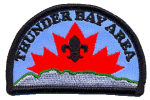

What to bring Canoeing
in Northern Ontario
Scouts Canada - Thunder Bay Area requires a Float
Plan. It is a good idea even if you are not going on a Scouting
Canoe Trip. List your route, when and where you plan to camp,
your entry and exit points. List the vehicle Licence Numbers, the
names of the people going, and where you will be leaving the
vehicles. Make a copy of the Float Plan, and leave it with a
relative or neighbour. Leave another copy with your outfitter,
Park Staff or Police at point of departure. If someone needs to
find you, they will at least know where to start
looking!

Packing Hints
Pack light! This is not a 50 Km backpacking adventure, but the
portages get longer the third time over!
A complete change of clothes, along with a sweat suit and wind
pants should be enough for a week. Everything in your pack should
do 2 or more functions.
One single burner Stove will prepare meals for 4 to 6 people.
Figure two stoves, and you will have lots of hot coffee
too!
There should be nothing loose in the canoe, everything should be
"waterproofed" and stored in a pack. The tent should be packed
with something that will float.
Have fun!
For Starters:
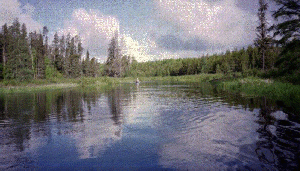
- Compass and Waterproof Map(s)
- Canoe: 17' (one for every 2 people)
- 25 foot Painter on each end of Canoe
- Bailing Can (cut from Javex jug or 2 L plastic pop bottle)
& Large Sponge
- P.F.D with Whistle attached (Must be
worn!)
- Paddles (+1 spare per canoe)
- Throw Bag with 15m boyant rope (for Canoe rescue) or a buoyant heaving line no less than 15 m (50') in length
- Repair Kit (Epoxy putty/Duct tape)
- Waterproof matches
- Canteen or water bottle
- Thermal Coffee Cup (For Drinking and Bailing)
- Knife and Survival Kit (Fanny Pack)
- Folding saw, Buck saw, or if you must, an Axe
- Flashlight and extra batteries and bulbs
- Sun protection (glasses, hat, sunscreen)
- First aid kit
- Insect repellent (No Sprays!)
- Spare prescription eyeglasses and medications
- Rain gear
- Fishing gear & licence
- Canoe kneeling pad (Closed cell foam/Blue sleeping pad)
- Trip Log Book or note pad
- Pencil
Packs:
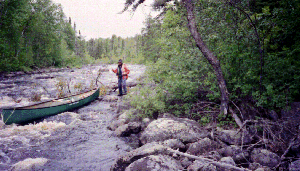 (As few and
as small as possible)
(As few and
as small as possible)
- External frame (proper fit critical)
- Internal frame (proper fit critical)
- Duluth Pack (85L is just right)
- Rucksack
- Day pack
- Fanny pack
- Stuff sacks (for organizing pack)
- Dry Pack (and something for wet clothes too)
- 23 Litre plastic pail (for your sleeping bag or camp kitchen,
and camp stool)
Note: To "water proof" your gear, put your stuff sack inside a
plastic garbage bag, and that inside a second stuff sack. This
will help prevent the garbage bag tearing and leaking. Don't
forget to keep your sleeping pad dry too, or your sleeping bag
will mop it dry for you!
Kitchen:
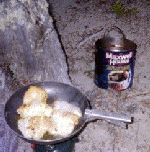
- Matches (waterproof)
- Camp Stove and fuel
- Cook kit and utensils
- Cup/Bowl/Plate
- Sealed containers (for food, spices, coffee/tea, etc.)
- Plastic bags (small and large)
- Aluminum foil
- Biodegradable soap, dish towel
- Water purification tablets or filter
- 2 - 5 gallon water carrier
- Food (Repackage to waterproof and save weight)
- Juice/Sport Crystals (to flavour drinking water)
- Bear Bag (Some people hang their food in a tree)
- Lantern/ extra mantels (If you like to stay up late at
night)
- Kitchen Fly (Tarp or extra tent fly)
- Ropes & pegs for kitchen fly
- Ropes for Tarps and clothesline
Shelter:
- Tent (seam-sealed, with fly, pegs and poles)
- Tube of seam sealer
- Spare tent pegs
- Extra tie-down cord (50ft.)
- Emergency repair kit
Clothing:
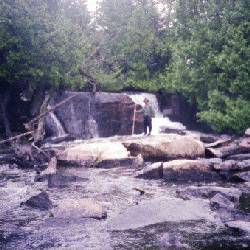
-
While Paddling
-
- Boots (proper fit and well broken in!!)
- Socks (acrylic or wool preferable)
- Long sleeve shirts & pants OR
- Shorts, T-shirts (depending on Sun, Bugs)
- Hat & lightweight fleece gloves
-
Packed to keep dry
-
- Camp Shoes (runners) (keep them dry!)
- Socks (acrylic or wool preferable)
- Sleeping Bag with temperature rating of -1° C or
better
(This is a Summer bag in NWO!)
- Lightweight underwear
- Shorts, T-shirts
- Long sleeve shirts & pants
- Fleece Jacket (evenings/cool, wet weather)
- Jogging Suit (PJ's and extra camp clothes)
- Bathing suit
- Insulation Layers (wool or synthetic fleece to suit
season)
- Rain/wind gear (jackets and pants or
poncho-waterproof/breathable)
- Toilet Kit: Comb, Toothbrush/paste
- Towel
- Biodegradable soap, shampoo
Optional Extras
- Camera & extra film (when will you be back this way? Is
one roll per day enough?)
- G.P.S. with extra batteries is nice to reference points of
interest. It is never used as the primary navigation tool. If you
bring one, you should have taken a course on using it.
- Personal Emergency Locator Beacon. In rough/remote country 3
or 4 days away from help, or for fly-in canoe trips, it may be
"peace of mind protection".

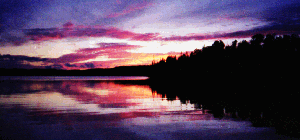
The Last Portage
In a small pack, left in the car:
- Towel
- Biodegradable soap, shampoo
- Comb, Toothbrush/paste, razor
- Socks, Underwear
- Comfortable shirt, pants
- Comfortable shoes
- Can of Fruit etc. as a special Treat!
After the Last Portage, when the canoes are loaded on their
carrier, and all the gear is stowed away for travel, have a swim,
put on the clean dry clothes that you left in that pack in the
car. Clean dry everything, from the skin out including dry shoes
to travel in!
Note: This is a suggested list, and is only a start for
your personal packing list. Add or subtract as your needs and
experience change.
Ontario Provincial Parks have a ban on bottles and cans.
Everything you take with you must come back, even the garbage.
There are directions for the disposal of human waste. Ask for
them when you make your Reservations. Find out the rules first!
Remember this: Leave only footprints--Take only memories (and
lots of pictures!).


Index



 (As few and
as small as possible)
(As few and
as small as possible)



